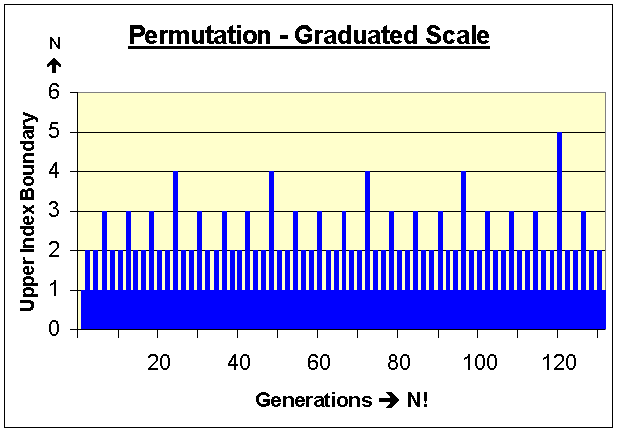| Number of Objects to Permute (N) |
a[N] Display of Initial Sequence |
a[N] Display of Final Sequence |
Total Number of Unique Combinations Produced (N!) |
| 3 | 1 2 3 | 3 2 1 | 2 * 3 = 6 |
| 4 | 1 2 3 4 | 4 3 2 1 | 6 * 4 = 24 |
| 5 | 1 2 3 4 5 | 5 4 3 2 1 | 24 * 5 = 120 |
| 6 | 1 2 3 4 5 6 | 6 5 4 3 2 1 | 120 * 6 = 720 |
| 7 | 1 2 3 4 5 6 7 | 7 6 5 4 3 2 1 | 720 * 7 = 5040 |
| 8 | 1 2 3 4 5 6 7 8 | 8 7 6 5 4 3 2 1 | 5040 * 8 = 40320 |
| 9 | 1 2 3 4 5 6 7 8 9 | 9 8 7 6 5 4 3 2 1 | 40320 * 9 = 362880 |
| N | 1 2 3 . . . (N - 1) N | N (N - 1) . . . 3 2 1 | (N - 1)! * N = N! |
Often duplicate generations within a complete permutation set are not desirable. If there are duplicate elements within a target array, there will be duplicate generations within the permutation set. The QuickPerm Reversal Algorithm presented above stemmed from an early single-pass Palindrome Detection Algorithm I developed in the year 1984. Depending upon the upper and lower indices, duplicate generations - as a fractional palindrome substring - can be detected and omitted when target elements are swapped. Consider two fundamental target strings such as "ABCDEFFEDCBA" and "ABCDEFABCDEF" to research duplicate patterns within ordered permutation sets. (Please note, the examination of target arrays violates a previously stated guideline: "The linear permutable target can NOT be examined".) Presented below is a "Permutation Ruler" which illustrates this eloquent principle:
A Permutation Ruler: (The Origin)

Next is EXAMPLE 04 which inclusively reverses elements from index i to index j. (Tail Reversals)